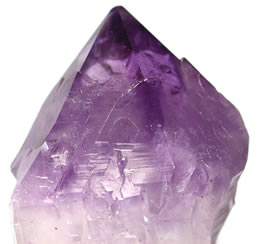Here's where I'm at with the material so far:
I've been trying for the past couple weeks to model some Amethyst and have been banging my head against the desk so to speak. The problem I'm having is in modeling the volumetrics accurately. In most pictures I can find of amethyst it starts at the bottom of the crystal growth as a dense white material moving into a light purple, becoming more densely purple near it's tip. See below:
Here's my problem. I've found that no amount of volume absorption, or volume scatter set to white at ANY density looks right. I've tried them separately and I've tried combining them with an add shader. The volume scatter always looks too much like smoke even at very high densities and I can't really seem to get the effect of very dense white crystal that is apparent at the bottom of most amethyst.
Right now, the way I'm achieving the white bottom on the crystal is to blend between a diffuse shader and a glass shader using a gradient texture that I control by a vector mapping node to get it lined up just right. The problem with this is that a real amethyst crystal would still be a crystalline material at the bottom, albeit far too dense and white to see through. Volume scatter and absorption techniques didn't seem to allow me to achieve this so I'm sort of faking the white bottom, but I would definitely like the white bottom of the amethyst to look as realistic as possible in my amethyst material.
Some help would be greatly appreciated!







